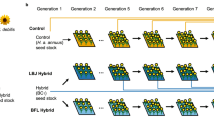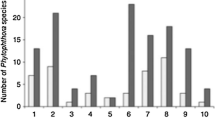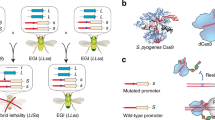Abstract
The success or failure of hybrids and the factors that determine their fitness have ecological, evolutionary, medical, and economic implications. Hybrid fitness is a major determinant of the size of hybrid zones and the maintenance of related species with overlapping ranges. It also influences the evolution of emerging pathogens and the success of economically important crop species experimentally hybridized in search of strains with increased yields or disease resistance. Hybrid fitness may largely be determined by the pervasiveness of epistasis in the genome, as epistasis is known to debilitate hybrids through disrupted inter- and intragenic interactions. We identified two bacteriophages isolated from their natural environment, one the result of a past hybridization event involving an ancestor of the other phage and a third, unknown phage. By performing a reciprocal cross of the affected region of the genome, consisting of a single complete gene, we both approximately recreated and reversed this original hybridization event in two chimeric bacteriophage genomes. Subsequent adaptation of the hybrid phages allowed for the recovery of fitness losses incurred by the hybrid genotypes. Furthermore, adaptation led to the ascension of a substantially higher and previously inaccessible adaptive peak. We show that by allowing genotypes to take large leaps across the adaptive landscape rather than single mutational steps, hybridization can lead to huge long-term fitness gains in spite of short-term costs resulting from disrupted epistatic interactions, demonstrating that the success or failure of hybrids may be determined not by their initial fitness, but rather by their adaptive potential.



Similar content being viewed by others
References
Baack EJ, Rieseberg LH (2007) A genomic view of introgression and hybrid speciation. Curr Opin Genet Dev 17(6):513–518
Barton NH (2001) The role of hybridization in evolution. Mol Ecol 10(3):551–568
Bull JJ, Badgett MR, Wichman HA, Huelsenbeck JP, Hillis DM, Gulati A, Ho C, Molineux IJ (1997) Exceptional convergent evolution in a virus. Genetics 147:1497–1507
Burkart-Waco D, Josefsson C, Dilkes B, Kozloff N, Torjek O, Meyer R, Altmann T, Comai L (2012) Hybrid incompatibility in Arabidopsis is determined by a multiple-locus genetic network. Plant Physiol 158(2):801–812
Burke JM, Arnold ML (2001) Genetics and the fitness of hybrids. Annu Rev Genet 35:31–52
Chang AS, Bennett SM, Noor MAF (2010) Epistasis among Drosophila persimilis factors conferring hybrid male sterility with D. pseudoobscura bogotana. PLoS One 5(10):e15377
Chen ZJ (2010) Molecular mechanisms of polyploidy and hybrid vigor. Trends Plant Sci 15(2):57–71
Cooper TF, Rozen DE, Lenski RE (2003) Parallel changes in gene expression after 20,000 generations of evolution in Escherichia coli. Proc Natl Acad Sci USA 100(3):1072–1077
Coyne JA, Orr HA (2004) Speciation. Sinauer Associates, Sunderland (MA)
Cunningham CW, Jeng K, Husti J, Badgett M, Molineux IJ, Hillis DM, Bull JJ (1997) Parallel molecular evolution of deletions and nonsense mutations in bacteriophage T7. Mol Biol Evol 14(1):113–116
He CQ, Han GZ, Wang D, Liu W, Li GR, Liu XP, Ding NZ (2008) Homologous recombination evidence in human and swine influenza A viruses. Virology 380(1):12–20
He CQ, Ding NZ, Mou X, Xie ZX, Si HL, Qui R, Ni S, Zhao H, Lu Y, Yan H, Gao Y, Chen L, Shen X, C RN (2012) Identification of three H1N1 influenza virus groups with natural recombinant genes circulating from 1918 to 2009. Virology 427(1):60–66
Humphrey W, Dalke A, Schulten K (1996) VMD: visual molecular dynamics. J Mol Graph 14:33–38
Janousek V, Wang L, Luzynski K, Dufkova P, Vyskocilova MM, Nachman MW, Munclinger P, Macholan M, Pialek J, Tucker PK (2012) Genome-wide architecture of reproductive isolation in a naturally occurring hybrid zone between Mus musculus musculus and M. m. domesticus. Mol Ecol 21(12):3032–3047
Kubo T, Yoshimura A, Kurata N (2011) Hybrid male sterility in rice is due to epistatic interactions with a pollen killer locus. Genetics 189(3):1083–1092
Liu W, Liu Y, Liu J, Zhai J, Xie Y (2011) Evidence for inter- and intra-clade recombinations in rabies virus. Infect Genet Evol 11(8):1906–1912
Lobkovsky AE, Koonin EV (2012) Replaying the tape of life: quantification of the predictability of evolution. Front Genet 3(246):1–8
Lyons S, Sharp C, LeBreton M, Djoko CF, Kiyang JA, Lankester F, Biblia TG, Tamoufe U, Fair J, Wolfe ND, Simmonds P (2012) Species association of Hepatitis B virus (HBV) in non-human apes; evidence for recombination between gorilla and chimpanzee variants. PLoS One 7(3):e33430
Maheshwari S, Barbash DA (2011) The genetics of hybrid incompatibilities. Annu Rev Genet 45:331–355
McKenna R, Xia D, Willingmann P, Ilag L, Krishnaswamy S, Rossmann M, Olson N, Baker T, Incardona N (1991) Atomic structure of a single-stranded DNA bacteriophage phiX174 and its functional implications. Nature 355(6356):137–143
Motomura K, Chen J, Hu WS (2008) Genetic recombination between human immunodeficiency virus type 1 (HIV-1) and HIV-2, two distinct human lentiviruses. J Virol 82(4):1923–1933
Orr HA, Irving S (2001) Complex epistasis and the genetic basis of hybrid sterility in the Drosophila pseudoobscura Bogota-USA hybridization. Genetics 189:1089–1100
Pepin KM, Wichman HA (2007) Variable epistatic effects between mutations at host recognition sites in φX174 bacteriophage. Evolution 61:1710–1724
Pepin KM, Samuel MA, Wichman HA (2006) Variable pleitropic effects from mutations at the same locus hamper prediction of fitness from a fitness component. Genetics 172:2047–2056
Presgraves DC (2007) Speciation genetics: epistasis, conflict and the origin of species. Curr Biol 17(4):125–127
R Development Core Team (2010) R: a language and environment for statistical computing. R Foundation for Statistical Computing, Vienna, Austria, URL http://www.R-project.org/, ISBN 3-900051-07-0
Rigby ST, Rose AE, Hanson MN, Bambara RA (2009) Mechanism analysis indicates that recombination events in HIV-1 initiate and complete over short distances, explaining why recombination frequencies are similar in different sections of the genome. J Mol Biol 388(1):30–47
Rokyta DR, Wichman HA (2009) Genic incompatibilities in two hybrid bacteriophages. Mol Biol Evol 26:2831–2839
Rokyta DR, Burch C, Caudle SB, Wichman HA (2006) Horizontal gene transfer and the evolution of microvirid coliphage genomes. J Bacteriol 188:1134–1142
Rokyta DR, Abdo Z, Wichman HA (2009) The genetics of adaptation for eight microvirid bacteriophages. J Mol Evol 69:229–239
Saxer G, Doebeli M, Travisano M (2010) The repeatability of adaptive radiation during long-term experimental evolution of Escherichia coli in a multiple nutrient environment. PLoS One 5(12):e14184
Ssemwanga D, Lyagoba F, Ndembi N, Mayanja BN, Larke N, Wang S, Baalwa J, Williamson C, Grosskurth H, Kaleebu P (2011) Multiple HIV-1 infections with evidence of recombination in heterosexual partnerships in a low risk rural clinical cohort in Uganda. Virology 411(1):113–131
Su MW, Yuan HS, Chu WC (2011) Recombination in the nonstructural gene region in type 2 dengue viruses. Intervirology 55(3):225–230
Szendro IG, Franke J, de Visser JAGM, Krug J (2012) Predictability of evolution depends nonmonotonically on population size. Proc Natl Acad Sci USA 110(2):571–576
Wang H, Zhang W, Ni B, Shen H, Song Y, Wang X, Shao S, Hua X, Cui L (2010) Recombination analysis reveals a double recombination event in hepatitis E virus. Virol J 7(129):1–6
Wichman HA, Badgett MR, Scott LA, Boulianne CM, Bull JJ (1999) Different trajectories of parallel evolution during viral adaptation. Science 285(5426):422–424
Woods R, Schneider D, Winkworth CL, Riley MA, Lenski RE (2006) Tests of parallel molecular evolution in a long-term experiment with Escherichia coli. Proc Natl Acad Sci USA 103(24):9107–9112
Acknowledgments
Part of the initial adaptation of ID204 was performed by Marshall Wingerson. This work was supported by funding from the United States National Institutes of Health (NIH) granted to DRR (Grant Number NIH R01GM099723).
Author information
Authors and Affiliations
Corresponding author
Rights and permissions
About this article
Cite this article
Sackman, A.M., Rokyta, D.R. The Adaptive Potential of Hybridization Demonstrated with Bacteriophages. J Mol Evol 77, 221–230 (2013). https://doi.org/10.1007/s00239-013-9586-8
Received:
Accepted:
Published:
Issue Date:
DOI: https://doi.org/10.1007/s00239-013-9586-8




